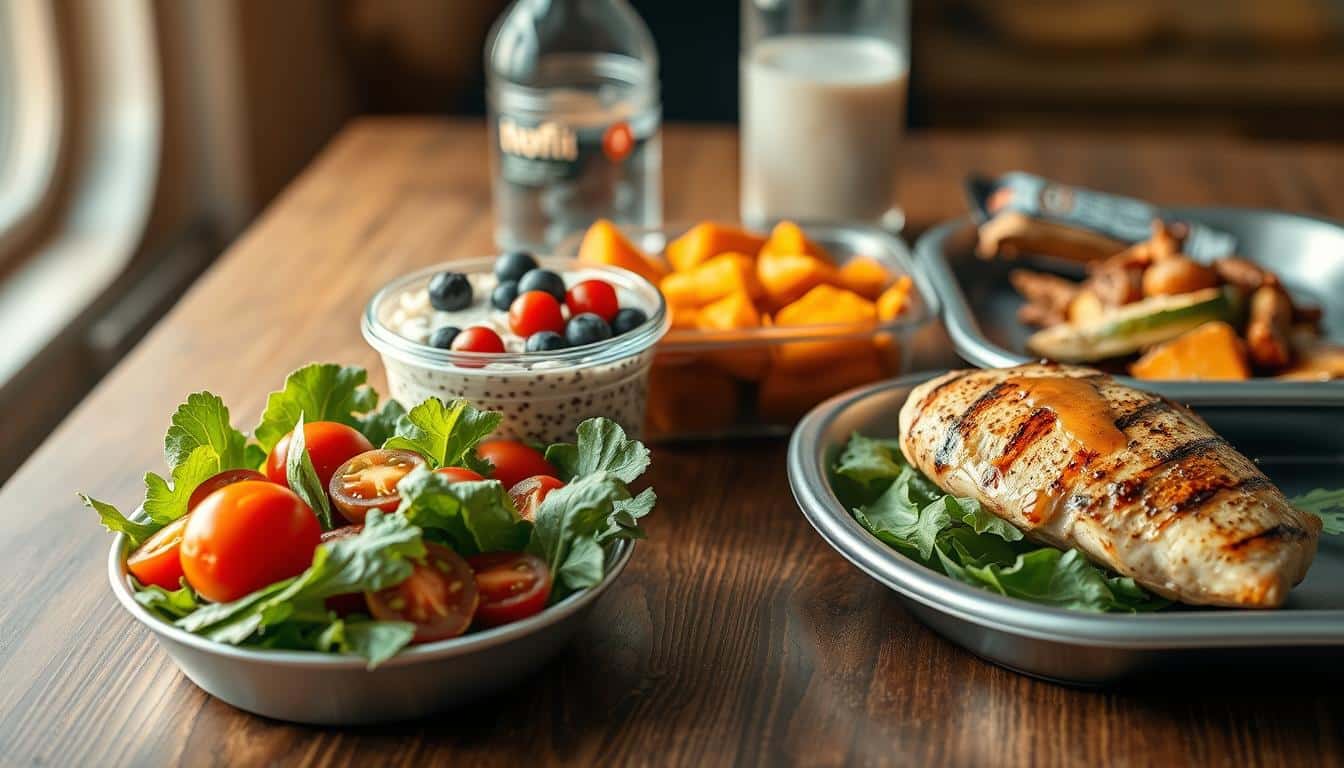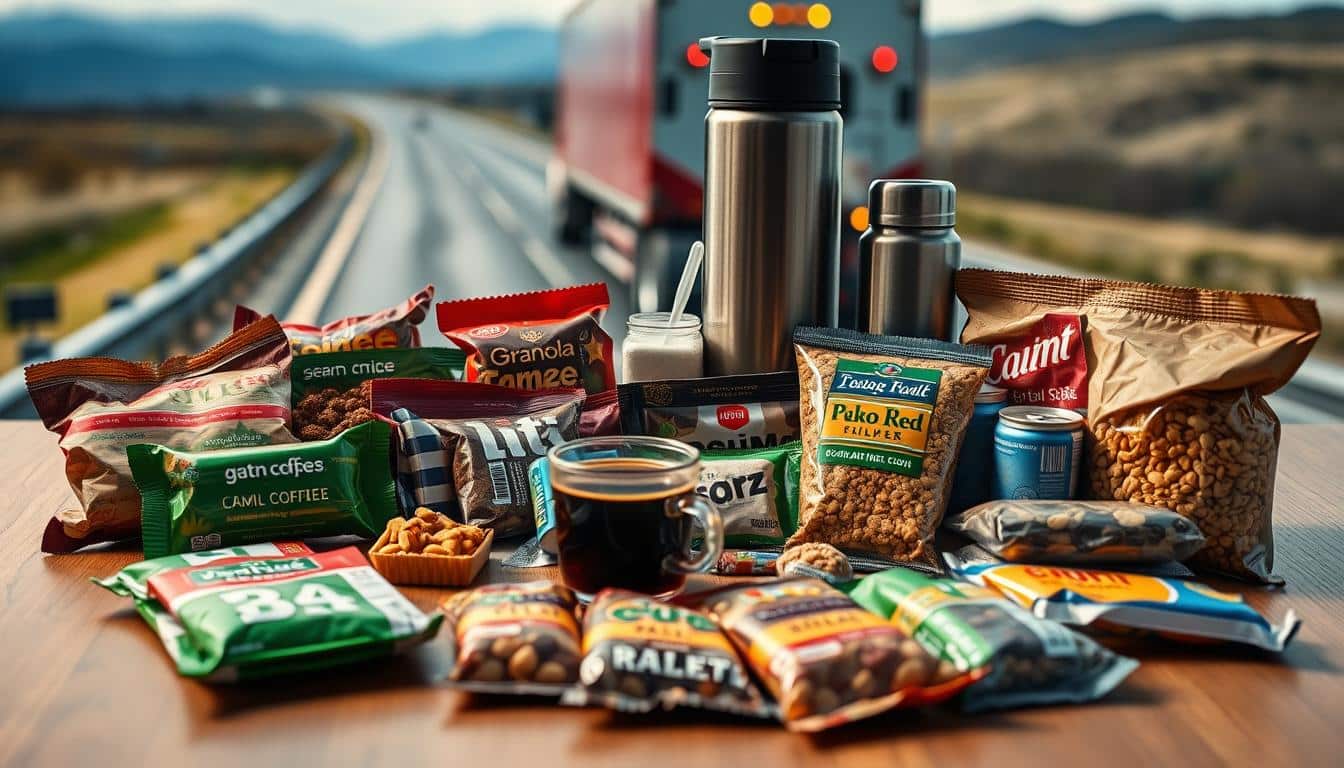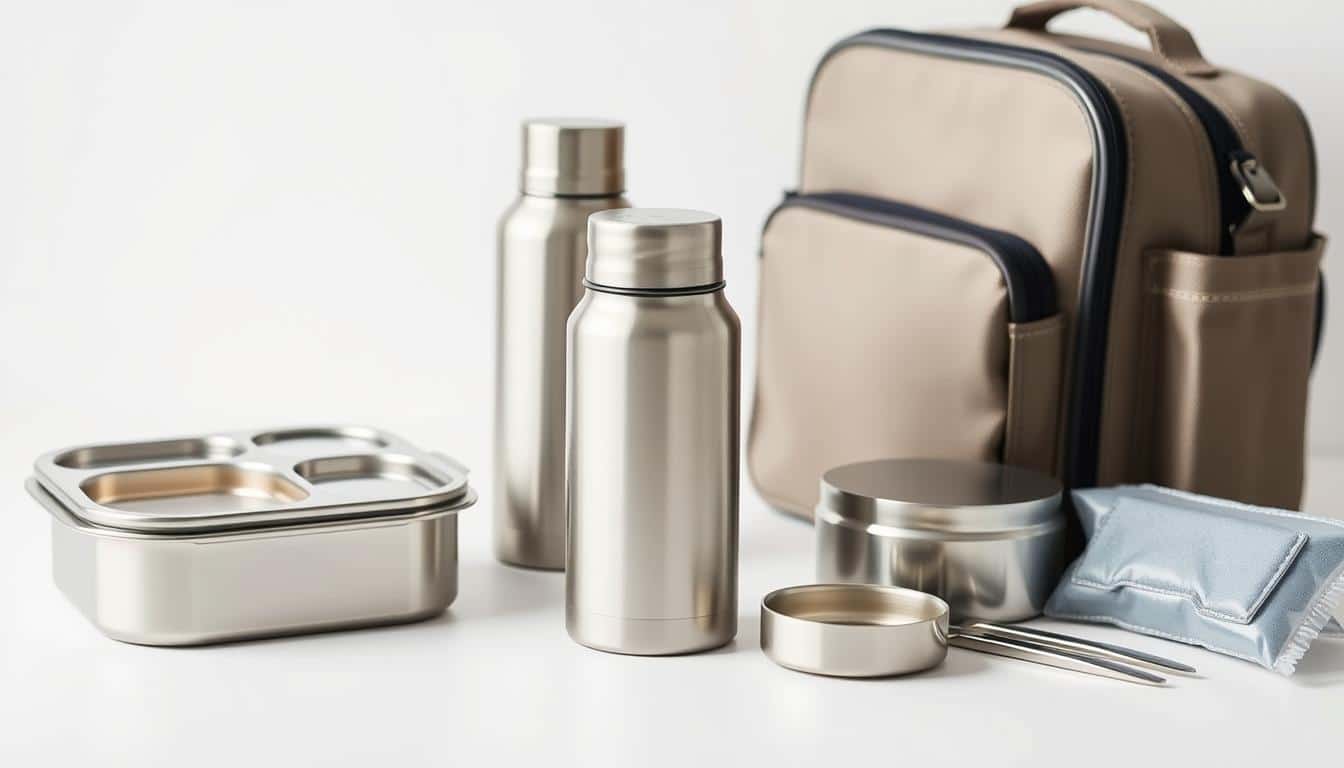Eating well is tough for long-haul truckers. Truck-stop food often has too many calories and too much fat. Cooking in the cab lets truckers pick what they eat, save money, and still enjoy tasty meals.
Truckers can cook easily on the road with small tools. They can make simple meals like oats, burritos, salads, and pasta. These meals are quick to make and keep truckers energized while driving.
Being prepared makes a small cooking space work better. Truckers can pack healthy snacks like muffins and trail mix. They can also prepare wraps and protein bowls ahead of time. This helps them eat better, save money, and stay alert on long drives.
Why cab cooking matters for long-haul drivers
Cooking in the cab lets drivers choose what they eat and how much. This way, they stay healthier and keep their energy up while driving. Switching to lean meats, whole grains, and less salt cuts down on fat and calories.
Eating breakfasts and soups made at home helps you stay full longer. A thermos keeps food hot when you can’t warm it up. Foods like sandwiches, eggs, salads, and wraps are easy, no-heat options for a busy day.
Health and energy benefits of home-prepared meals
Making your own meals means you eat less fried and processed food from truck stops. Eating foods that are good for you helps you focus better and avoids energy drops. Balanced meals also lead to better sleep and even blood sugar, which means better health for truckers.
Fast recipes like burritos or stir-fries are packed with protein and fiber, giving you energy that lasts. Bringing healthy snacks prevents the urge to buy junk food that makes you tired.
Cost savings compared to truck-stop meals
Cooking your own meals saves money by reducing the need to eat out. Making meals in advance and bringing lunch can really help you save. Using kitchen gadgets like a rice cooker or skillet lets you cook in bulk, which is cheaper.
Planning your meals saves money by avoiding expensive, last-minute food buys. Bringing along homemade chicken salad or wraps helps stretch your food budget further and cuts down on eating out.
How meal planning reduces temptation and improves focus
Planning meals helps drivers avoid making unhealthy food choices during trips. Having prepared food means less temptation to eat fast food. This planning keeps your energy up and makes driving safer.
- Start small: prep one breakfast or one dinner for the week.
- Use a thermos or insulated containers to keep meals ready to eat.
- Rotate easy recipes so variety stays interesting without extra effort.
Essential portable cooking gear for truckers
Having the right gear makes eating well on the road easier. It helps truckers eat healthier, save cash, and cook in their cab. Here are small, powerful tools that fit in most trucks and connect to the cab’s power.
12-volt coolers and in-truck refrigerators
A 12-volt cooler keeps food fresh by plugging into the cab. An in-truck fridge offers more space and consistent cooling for essentials. These options help skip fast food and pack healthier meals.
- Choose models with thermostat control and low-watt draw.
- Look for compressor units if you need long trips with frozen items.
- Stackable containers help use fridge space efficiently.
Portable electric cookers, rice cookers, and slow cookers
Portable rice cookers and slow cookers let you make a variety of dishes. You can cook grains, veggies, and simple meals in a rice cooker. A slow cooker prepares chili, soups, and chicken while you’re busy or resting.
- Pick low-watt models designed for 12-volt outlets or use an inverter rated for the device.
- Choose nonstick inner pots for easy cleanup.
- Use glass or insulated lids to retain heat and reduce energy use.
Lunchbox cookers, thermoses, and small skillets
Lunchbox cookers heat up food quickly during breaks. A good thermos keeps your soup or stew warm for hours. Small skillets or induction pans are perfect for making eggs, stir-fries, and sandwiches.
- Opt for compact, low-wattage lunchbox cooker models that fit cab outlets.
- A sturdy thermos replaces microwaves for many drivers.
- Carry a lightweight skillet for last-minute breakfast or reheating.
Combining some of these tools can meet all your meal needs without big devices. This approach offers variety, saves electricity, and makes cleaning easier when traveling.
Smart food storage and safety tips for life on the road
Storing food safely in a truck needs a good plan. Smart practices help you waste less food, save money, and stay healthy. Here’s how to keep perishables fresh in tight spaces and maintain a clean area for meal prep.
How to safely store perishables in a cooler or mini-fridge
Opt for a high-quality 12-volt cooler or a truck fridge with a trustworthy thermostat. Put raw meats on the bottom shelf to prevent drips. Seal perishables in air-tight containers or vacuum-sealed bags for longer freshness.
Do daily checks on the temperature. Keep cool items at or below 40°F. For hot foods, use a thermos to keep them above 140°F. Frequent temperature monitoring boosts food safety for drivers.
Portioning and using resealable bags to prevent waste
Divide meals into single portions using containers or zipper bags before hitting the road. This approach helps avoid spoilage and speeds up meals. Always mark bags with the date to keep track of their freshness.
- Portioning food helps control eating and ensures consistent meal sizes.
- Picking transparent bags or containers makes it easy to see contents at a glance.
- Freezing meal parts and defrosting them in your cooler overnight is also smart.
Sanitation basics: wipes, surface cleaners, and safe reheating
Have non-fragranced disinfecting wipes and gentle cleaners for surfaces and gear. Use specific utensils to avoid germ spread. Use hand wipes when you can’t wash your hands.
Heat food properly by following your appliance’s instructions. Use appliance-appropriate containers in microwaves. Stick to manufacturer tips for slow cookers and rice cookers to keep food safely hot.
- Clean your cooking area well before and after preparing food to keep your truck clean.
- Cool down cooked food before sealing them to stop bacteria from growing.
- Store cut-up veggies and pre-cooked meats in sealed containers for quick access and to keep your cooler organized.
Quick trucker recipes
Breakfast is key for a trucker’s long day. These quick meal ideas are all about being fast, healthy, and easy to make in your truck. Try different ones throughout the week. Just make sure to have basics like tortillas, eggs, oats, cheese, and fruit ready in your cooler or mini-fridge.
These methods are great for a lunchbox cooker, microwave, or skillet. They save time, cut costs, and make your mornings easier on the road.
-
One-pan breakfast burritos: Start by browning diced bacon or turkey sausage in a skillet. Then, push the meat aside, scramble some eggs right there, and mix. Warm a tortilla, sprinkle cheese and add salsa, then roll. Keep it in foil in the fridge; reheat in the microwave or on a skillet when it’s time to go.
-
Mug meals and microwave breakfast options: Beat two eggs with some milk, chopped bell pepper, and cheese in a mug. Microwave in short bursts. You can also make mac and cheese or oatmeal this way. These meals are quick and only need a spoon for cleaning.
-
Overnight oats for truckers: Mix rolled oats with milk or Greek yogurt. Add berries, nuts, and honey in a jar. Let it sit overnight in your fridge. In the morning, it’s ready to go. This gives you energy that lasts and is easy to eat on the move.
Also consider boiled eggs, oat-and-fruit muffins, and egg bakes with veggies and meat. For hot meals, try soups or stews in a thermos. This way, you don’t need to cook much.
Start with preparing two or three breakfasts on Sunday. Change up the flavors to keep things interesting. Keep a list of your go-to microwave meals that fit your routine and truck setup.
One-pot and one-pan meals for easy cleanup
Keep meals simple when you’re tight on space and time. Use canned goods, chopped veggies, and quick proteins for tasty truck meals. They’re easy to make in the cab and good for you.
For a quick one-pan pasta, cook the noodles right in the sauce. First, cook garlic in olive oil. Then, add canned tomatoes and herbs. Mix in pasta and water until soft. Add spinach or bell peppers. Top it off with Parmesan for a simple, tasty dish with easy cleanup.
Make ramen noodles more exciting by skipping the seasoning packet. Fry garlic and onion, then add veggies and cooked chicken or tofu. Throw in the cooked noodles and a mix of soy sauce, sesame oil, and honey. You get a quick, flavorful stir-fry.
Truckers love meals they can cook in a rice cooker. It’s perfect for making quinoa or rice, veggies, and curry. Just add canned chickpeas or chicken. This method saves on cleanup and keeps your food warm.
- One-pan pasta idea: garlic, canned tomatoes, spinach, whole-wheat pasta, Parmesan.
- Ramen stir-fry idea: ramen noodles, mixed veggies, soy-sesame sauce, shredded chicken.
- Rice cooker meals truckers tip: quinoa, frozen mixed veggies, jarred curry, protein of choice.
Choose small cookware for your truck: a little skillet, a portable rice cooker, and a pot are enough. These help you make quick meals with little cleanup while keeping your meals varied.
Slow cooker and crockpot recipes for hands-off dinners
Slow cookers are perfect for drivers with long days. Set it up in the morning and come back to a hot meal. They’re great in small spaces with no mess. Make sure to use a small Crock-Pot or a 12-volt cooker. Always follow safety guidelines when using it in your cab.
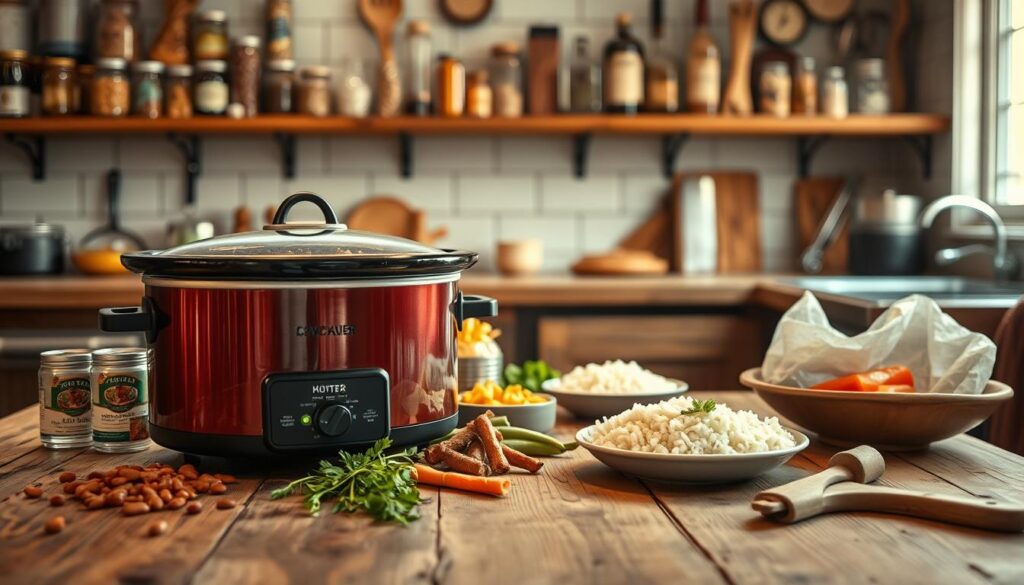
Start your day by making a beef stew or chili. This makes a hearty meal that’s good with bread or on its own. This meal is perfect for keeping you going during late nights. Plus, it’s cheaper than eating out at truck stops.
-
Beef stew: brown the meat, add veggies, broth, and herbs. Cooking it on low all day makes it tender.
-
Crockpot chili for truckers: try ground beef or turkey, with tomatoes, beans, and spices. It makes a lot for later.
Pulled pork or BBQ chicken is great for meals to last a few days. Use a pork shoulder for pulled pork. Cook on low with a simple rub. Then shred it for various dishes.
-
Pulled pork in crockpot: add some vinegar and BBQ sauce at the end. This keeps it juicy.
-
BBQ chicken: pick boneless thighs for tender and easy-to-shred chicken.
For lighter options, go vegetarian. Try bean stews and lentil soups. They’re full of protein but don’t need to be refrigerated. Use overnight-soaked or canned beans to save time.
-
Vegetarian slow-cooker meals: mix beans, tomatoes, carrots, spinach, and spices for a hearty stew.
-
Soup-in-a-thermos tip: put hot soup in a thermos. You’ll have a warm meal even hours later.
Add sides like steamed spinach, canned beans, or microwave rice to complete meals. Prepare in batches and use containers for easy storage. Follow reheating steps to ensure your food is delicious and your cab remains clean.
Healthy, no-heat meals for fuel without reheating
Long trips require food that stays good and fuels the body without a microwave. No-heat meals for trucks save on prep time, cut down fuel stops, and help keep drivers sharp. Fill a cooler with layered salads, protein boxes, and wrapped snacks for quick meals on the go.
Jar salads are easy and neat for meal prep. Start with wide-mouth mason jars. Put dressing at the bottom, then add hard veggies like carrots and cucumbers. Next, add some protein and leafy greens at the top. Shake it into a bowl or eat straight from the jar when you’re ready. These salads stay fresh in a cooler and keep their crunch for several days.
- Fill jars with chickpeas, quinoa, or grilled chicken for more energy.
- Keep dressing on the side to keep greens fresh.
- Mark your jars with dates to keep track of your meals.
Tuna salad is a smart and satisfying choice for truckers. Mix canned tuna with a little mayo or Greek yogurt, add diced celery, and some chopped pickles. Pack it in small containers for easy eating with whole-grain crackers, toast, or in cold wraps. Canned chicken is a good alternative when you want to mix things up.
- Opt for single-serve mayo packets or vacuum-sealed tuna to stay fresh.
- Add extra lemon wedges to boost flavor without needing to heat.
Cold wraps fix a lot of meal issues in the truck. Spread hummus or cream cheese on a tortilla. Then, add spinach, shredded carrots, and either sliced turkey or grilled chicken. Roll it tightly and slice for an easy-to-handle lunch. Try lettuce wraps for a crunchy, low-carb option.
- Make a bunch of cold wraps on Sunday for the week’s breakfasts and lunches.
- Wrap each one in parchment to keep them from getting wet.
- Keep them in a mini-fridge or cooler to stay fresh.
Having different meal options keeps no-heat truck meals interesting. Mix jar salads, tuna, and cold wraps with fruits, hard-boiled eggs, and raw veggies for variety. A little meal planning cuts down on waste and helps maintain energy during those long drives.
Snack prep and portion control strategies for truck cabs
Smart snack prep keeps your energy level steady and helps save money while on the road. Simple tools and a bit of planning let drivers have healthy snacks in their truck. They fit well in the cab and stay fresh. Use small containers, resealable bags, and labeled portions to reduce waste and avoid eating too much on impulse.
Pre-portioning snacks like trail mix, nuts, and dried fruit makes grabbing a healthy bite easy. Putting trail mix into 1/4-cup bags is good for controlling calories and getting quick energy. Have separate bags for almonds, walnuts, and dried cherries to keep things interesting.
- Use resealable snack bags or small mason jars for single servings.
- Measure portions at home to help with portion control while on the road.
- Write down the calories or protein on bags to keep track of what you eat.
Pack veggies with single-serve hummus or Greek yogurt dips for crunchy, satisfying snacks. Cheese-and-cracker packs are high in protein and can be made with portion control in mind. When you’re running low on fresh produce, pick up carrots or pre-cut fruit at truck stops like Love’s.
- Put carrot sticks, cucumber rounds, and bell pepper strips in zip bags.
- Portion out hummus into 2–3 tablespoon containers to control how much you eat.
- Make packs with cheese, whole-grain crackers, and turkey slices for a quick protein snack.
For sweet cravings, choose healthy options like frozen grapes, fruit bars, and yogurt cups. These can be kept in a 12-volt cooler or mini-fridge. Dates or fig bars are great for a natural sugar boost when needed.
- Freeze grapes before your trip for a treat that’s like candy.
- Put yogurt in small containers and add a bit of granola on top.
- Keep mixed nuts and dried fruit in labeled bags so they’re easy to find and eat.
Rotate between three or four snack combos to keep things interesting. This helps with portion control and reduces the urge to buy unhealthy snacks. Regular snack prep makes snacking a way to fuel your body, not distract you.
Time-saving meal-prep routines for weekly trips
Simple routines help keep food fresh and lower stress on the road. Planning ahead cuts shopping time and fewer stops for takeout. Choose a couple of flexible recipes and switch them up.
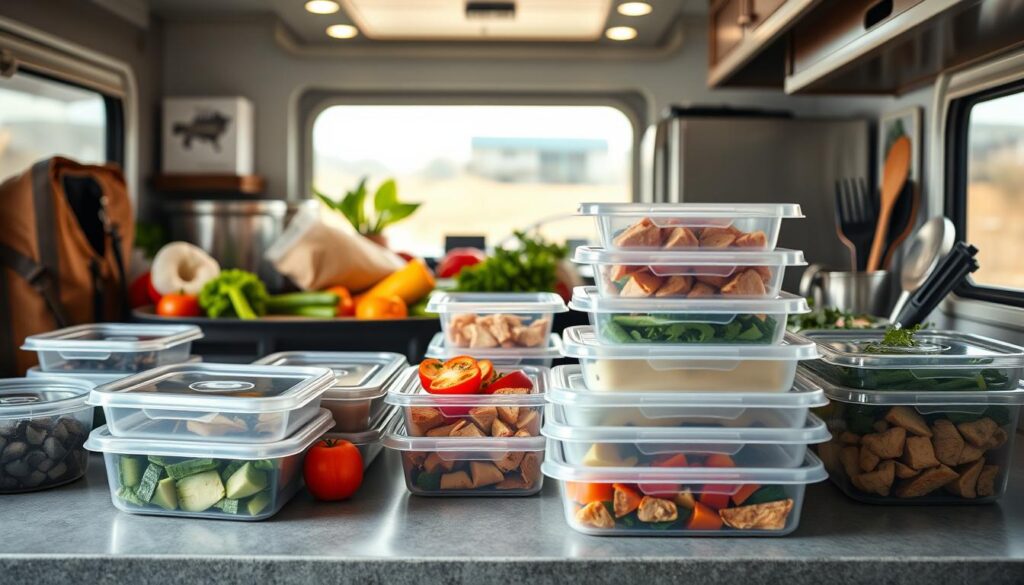
Begin with something easy. Pick one breakfast and lunch to make ahead for several days. Starting small with meal prep makes it easier and cuts down on waste.
-
Make three jars of overnight oats, each with different toppings.
-
Prepare a bunch of hard-boiled eggs and divide up some fruit.
-
Put together two chicken wraps for quick grab-and-go lunches.
Mix meals to keep things interesting. Cook a lot of one protein and use it in various meals. Grilled chicken can turn into tacos, salads, and other dishes.
-
Change between rice, quinoa, or pasta for different meals.
-
Try salsas, pesto, or soy-ginger sauce for new tastes.
-
Have pickles or olives ready to add a quick twist to any dish.
For a solid plan, mix slow-cooker dinners and pre-made breakfasts and lunches. You get a one-week menu for trucking that saves time each evening.
-
Choose three dinners, three lunches, and three breakfasts for the plan.
-
Make lots of proteins like pulled pork and grilled chicken ahead of time.
-
Divide everything into containers with labels for the days and cool them down fast.
Focus on quick and simple recipes. Try one-pan burritos, easy stir-fries, and meals in a mug to save time. Replenish fresh supplies at Love’s Travel Stops to keep on schedule.
Follow this guide to create a meal plan that works with trucking schedules and breaks. Small steps lead to big benefits on the road, making meal prep seamless for truckers.
Recipes for limited-space grilling and foil-packet cooking
Grilling makes dinners tasty without much gear. It suits truckers and quick stops. A small propane grill or campground ones make it easy.
With these tips, cooking in small spaces gets easier. You’ll need heavy-duty foil, single-serve sauces, and ready ingredients. This saves time and cuts waste.
- Loaded baked potato packet
- Slice potatoes thin, cooked or raw.
- Add shredded cheese, bacon or ham, and green onions.
- Season with salt, pepper, and garlic powder. Wrap it well in foil.
- Cook on medium heat for 15–20 minutes until tender. Enjoy with sour cream packets.
- Grilled fruit skewers
- Skewer pineapple, strawberries, and mango.
- Glaze with lime juice and honey. Mix them well.
- Grill each side until they’re warm and golden. A perfect snack or dessert.
Change up the main dish like chicken skewers. Marinate them early in zip-top bags. Choose cut veggies to make it faster.
Turn ramen and rice cooker dishes to foil meals. Use solid, cooked additions. Cook thicker veggies ahead to ensure they’re done.
- Practical foil-packet ideas
- Try a fish fillet with lemon, butter, and dill.
- Italian sausage tastes great with peppers and onions.
- For a veggie choice, mix mushrooms with garlic and thyme.
Always grill safely on trips. Use strong foil and close it well. Watch the heat to stop fire risks. Have a fire extinguisher and a thermometer ready.
Pack sauces in single-use packets from brands like Heinz. Keep food safe in a 12-volt cooler. Use zip bags to control portions.
Meal ideas for different times of day: breakfast, lunch, dinner, desserts
Plan meals around your driving schedule, keeping prep time short. Stick to simple ingredients like eggs, oats, and frozen fruits. These ideas will help you stay energized and cut down on truck stop visits.
Quick breakfast ideas to keep you energized on long hauls
- Mug omelet with egg, chopped bell pepper, and cheddar for a fast breakfast for truckers.
- Overnight oats with Greek yogurt, nuts, and berries for grab-and-go mornings.
- Whole-wheat muffins made with oats and fruit, or store-bought Kind bars for a reliable option.
- Boiled eggs plus a banana and peanut butter packet for portable protein.
High-protein, low-effort lunches to avoid truck-stop pitfalls
- Jar salads layered with romaine, cherry tomatoes, grilled chicken, quinoa, and a vinaigrette on the side — a set of high-protein lunch ideas that travel well.
- Turkey and avocado wraps using flatbreads or lettuce wraps and a side of cottage cheese or almonds.
- Protein bowls: pre-cooked rice, black beans, salsa, and shredded rotisserie chicken for quick warming or cold eating.
- Simple tuna or chicken salad packs with whole-grain crackers for a fast, filling choice.
Comforting dinner options you can make in-cab or prep ahead
- Slow-cooker chili or beef stew prepped before a run and portioned for reheating as in-cab dinner recipes.
- One-pot pasta with canned tomatoes, spinach, and Italian sausage for a hearty meal that needs minimal cleanup.
- Rice-cooker curry with chickpeas and frozen mixed veggies; serve over quinoa for a wholesome bowl.
- Foil-packet baked potatoes topped with pulled pork or BBQ chicken for a filling roadside dinner.
Don’t forget the desserts. Treat yourself to frozen grapes, fruit bars, or single-serve ice cream. These treats make long nights better without spoiling your diet.
Conclusion
Eating right while traveling can be easy with some prep, the right equipment, and willpower. This guide to cooking in your cab highlights simple steps. Start with small changes, portion your snacks, use thermoses, and choose meals that don’t need heating. These tips help you save money while eating better. Quick recipes, like overnight oats, jar salads, and one-pot pasta, simplify your mornings and nights without needing a full kitchen.
Having limited space doesn’t mean you can’t have variety in your meals. With basic tools like a skillet, microwave, or a portable cooker, and making stops for fresh foods, you can keep your meals interesting. An investment in key items such as a rice cooker, crockpot, or a small cooler is worthwhile. It means truckers preparing their own meals will depend less on fast food and more on nutritious meals. These choices help maintain energy and focus on the road.
Stick to simple, repeatable recipes like one-pan dishes, stir-fries, and pre-made protein packs. This strategy makes long trips easier with less cleaning and fewer unplanned food stops. For drivers seeking reliable and delicious meals, these fast recipes and cooking tips offer a practical way to improve health. Plus, it helps save money on every trip.
FAQ
Why does cab cooking matter for long-haul drivers?
How does meal planning reduce temptation and improve focus?
What portable cooking gear is essential for truckers?
Can I safely store perishables in a truck without a full kitchen?
How can I prevent food waste and overeating on the road?
What sanitation basics should drivers follow when cooking in the cab?
What are quick breakfast ideas that work in small spaces?
How do I make a one-pan breakfast burrito in a truck cab?
What microwave-friendly or mug meals work on the road?
What one-pot meal ideas reduce cleanup but stay nutritious?
Can a rice cooker or crockpot replace a full stove for dinners?
What slow-cooker recipes work best for long hauls?
Which meals don’t require reheating and are good for grab-and-go?
How can I build a realistic one-week meal plan for the road?
What snack-prep strategies help with portion control in the cab?
What healthy sweet options are practical for truckers?
Are foil-packet and grilling recipes feasible for limited space?
What are safe grilling tips and foil-packet tricks?
How do I keep variety so meal-prep doesn’t get boring on the road?
Where can I buy fresh ingredients while on the road?
How should drivers choose portable appliances for truck power limits?
What are easy dessert ideas suitable for a cab fridge or cooler?
How can I safely reheat soups or stews when a microwave isn’t available?
Content created with the help of Artificial Intelligence.

